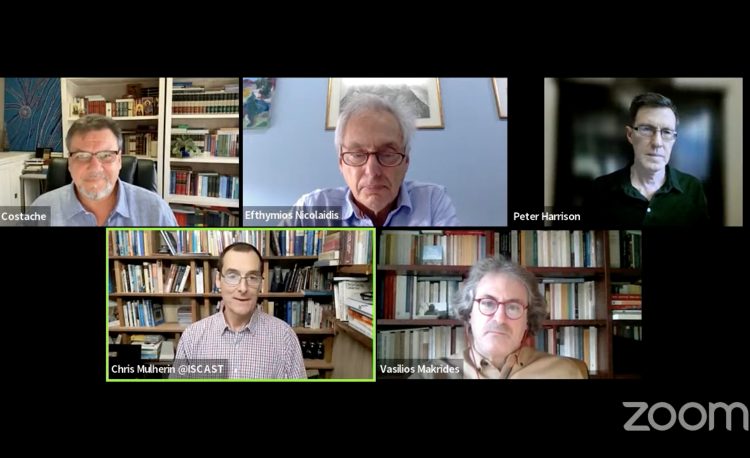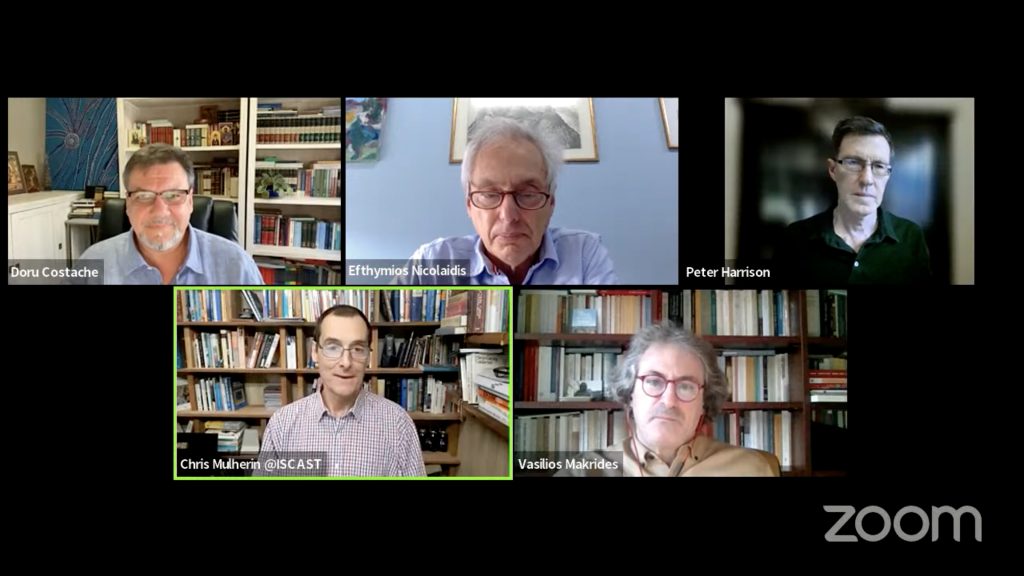On the occasion of the first ISCAST – SOW round table “Science, Theology, and Orthodox Christianity” (7 December 2021), I read the following short paper, which was preceded by the presentations of Prof. Vasilios Makrides (University of Erfurt) and Dr Efthymios Nicolaidis (Institute of Historical Research of the National Hellenic Research Foundation, Athens). Host of the event was Rev. Dr Chris Mulherin (ISCAST), while Prof. Peter Harrison, FAHA (University of Queensland) moderated the discussion.
I shall talk about two authors. One is early Christian, Clement of Alexandria, and the other, Maximus the Confessor, middle Byzantine.
Clement of Alexandria (d. ca 215) is the first Christian author who consistently addressed matters of faith and science, and he did so in a way that corresponds to the contemporary notion of scientifically engaged theology. His approach combined scientific (well, by the standards of his time), theological, and contemplative elements, for the purposes of establishing a Christian representation of reality. His method entails three steps. For convenience sake, I shall call these analysis, interpretation, and contemplation. That said, nowhere in Clement’s writings can be found a systematic exposition of this method nor is it mentioned in these very words. What I propose in what follows is my own reconstruction of his complex thinking, which I piece together from two of his books, Miscellanies and Prophetic Selections.
The first step consists in admiring the beautiful order of nature followed by a detailed analysis of things, which draws upon the available sciences—from research to experimental approaches, and from theorising about classes of beings to identifying the relations that hold together all things within the cosmos. Simply put, this step combines theory, experiment, analysis, and synthesis, in an effort to grasp the nature of cosmic order.
The second step of the method brings with it a radical change of angle, presupposing faith-based convictions. It is a matter of considering the scientifically obtained description of things through the lens of scriptural and liturgical images, for the purposes of articulating a Christian interpretation of reality. So perceived, the cosmos, for example, is a song of praise addressed to the Creator or a liturgical choir that sings that song. This is to say that cosmic order is theologically meaningful, communicating a message about God, ourselves, and the destiny of all creation.
These two stages of the method, namely, analysis and interpretation, correspond to what we would designate as science and religion or science and faith or, again, science and theology. Interestingly, Clement’s method draws a line between the two ways of knowing, scientific and theological, but without separating them, therefore avoiding both confusion and antagonism. The maturity of his approach anticipates the best of faith and science in our day and age.
In turn, the third step of his method, contemplation, is out of reach for most of us. Contemplation, here, means divine vision, a mystical grasp of things. This mystical insight into reality is the province of the saints—believers who attain such a level of personal transformation that, in God’s company, gaze upon things from a divine vantage point and divinely. What they see, Clement tells us, is a perfectly unified cosmos, where the individual beings no longer appear as out of sync with the universe, but one with it and with each other. The universe itself appears as a coherent, open book, with its past, present, and future experienced as one moment—much the way, we suppose, God perceives the spacetime continuum. While it is good to know that this divine way of knowing is possible, attaining it presupposes personal transformation. We retain, however, the significance of the first two steps, which show a capacity for integrating scientific knowledge into a theological narrative.
Fortunately for lower beings such as myself and many others, apart from certain intimations Maximus the Confessor (d. 662) does not challenge us to the extent that Clement’s method does.
Turning to Maximus, the greatest Byzantine theologian, I draw attention to his Book of Difficulties, in whose forty-first chapter he sketches what we could call a theory or a narrative of everything. In wide brushstrokes, Maximus depicts the whole of reality, from the most fundamental division between the created and the uncreated to the distinction between male and female. Specifically, reality appears to him as a sequence of five polarities. Each polarity encompasses two elements, with the next polarity being included in the second element of the previous polarity.
The first and widest polarity refers to the uncreated God and the created universe; the second polarity are the two sides of the universe, invisible and visible; the third one subdivides the visible reality into the sky and the earth; the fourth one is located on earth, and refers to paradise and the inhabited land. We recognise in this sketch of reality a Christian theological layer (the first polarity), the Platonic, metaphysical cosmos (the second polarity), the Aristotelian, scientific division of nature (the third polarity), and a scriptural layer (the fourth polarity). Maximus’ universe therefore is the product of a multifocal lens, theological, metaphysical, scientific, and scriptural.
It is against this complex backdrop that he introduces the fifth polarity, of gendered humankind, namely, subdivided into male and female, but without specifying where humanity is located. Is he talking about a paradisal humankind or of people dwelling in this civilised world of ours? The fact that Maximus leaves this matter fuzzy has to do, in my view, with the rest of his narrative, which focuses on humanity’s task to unify the disparate elements of the five polarities. Humankind can achieve unification—points out Maximus—only insofar as people choose to live paradisally, that is, by prioritising the spiritual life. Thus, humanity’s non-localisation denotes its task to make a free decision.
But let me return to the five polarities and the lenses they represent. Once again, and in the order of Maximus’ narrative, the first polarity entails a theological, or faith-based, conviction, the second one evokes the Platonic contemplation of reality, the third one iterates the Aristotelian scientific universe, the fourth one alludes to Genesis 2-3, and, finally, the fifth one evokes Genesis 1, where humankind is described as male and female. This is a multidisciplinary depiction of things, which brings together harmoniously different views of reality without blurring their contours. Each view to its polarity! There is much wisdom, here, for all who are interested in faith and science, including scientifically engaged theologians and theologically engaged scientists. And it goes the same for Clement and many other traditional confrères, in whose thinking there is no room for the conflict paradigm.
8 December 2021 © AIOCS
A related post, and another one, and another one



